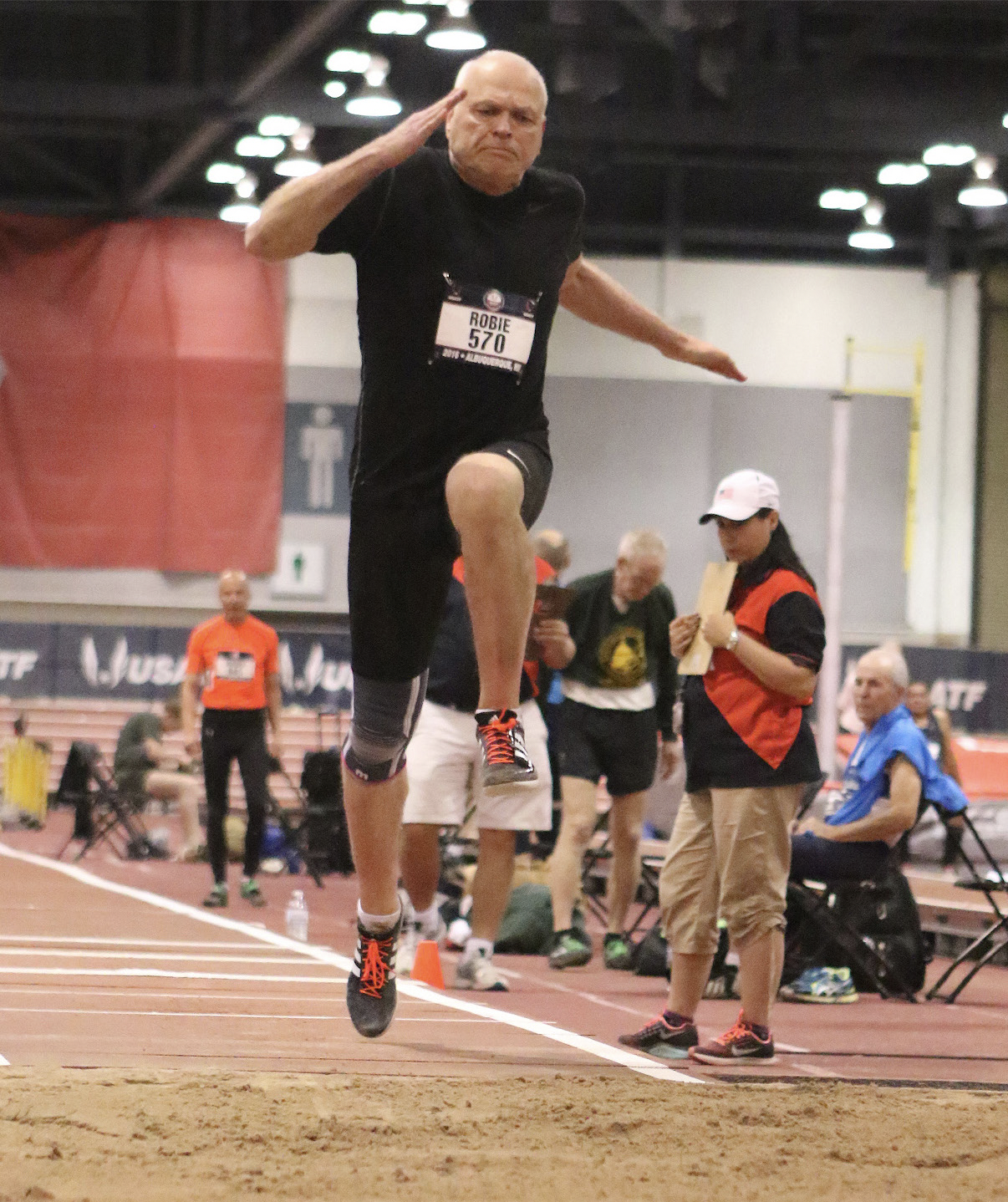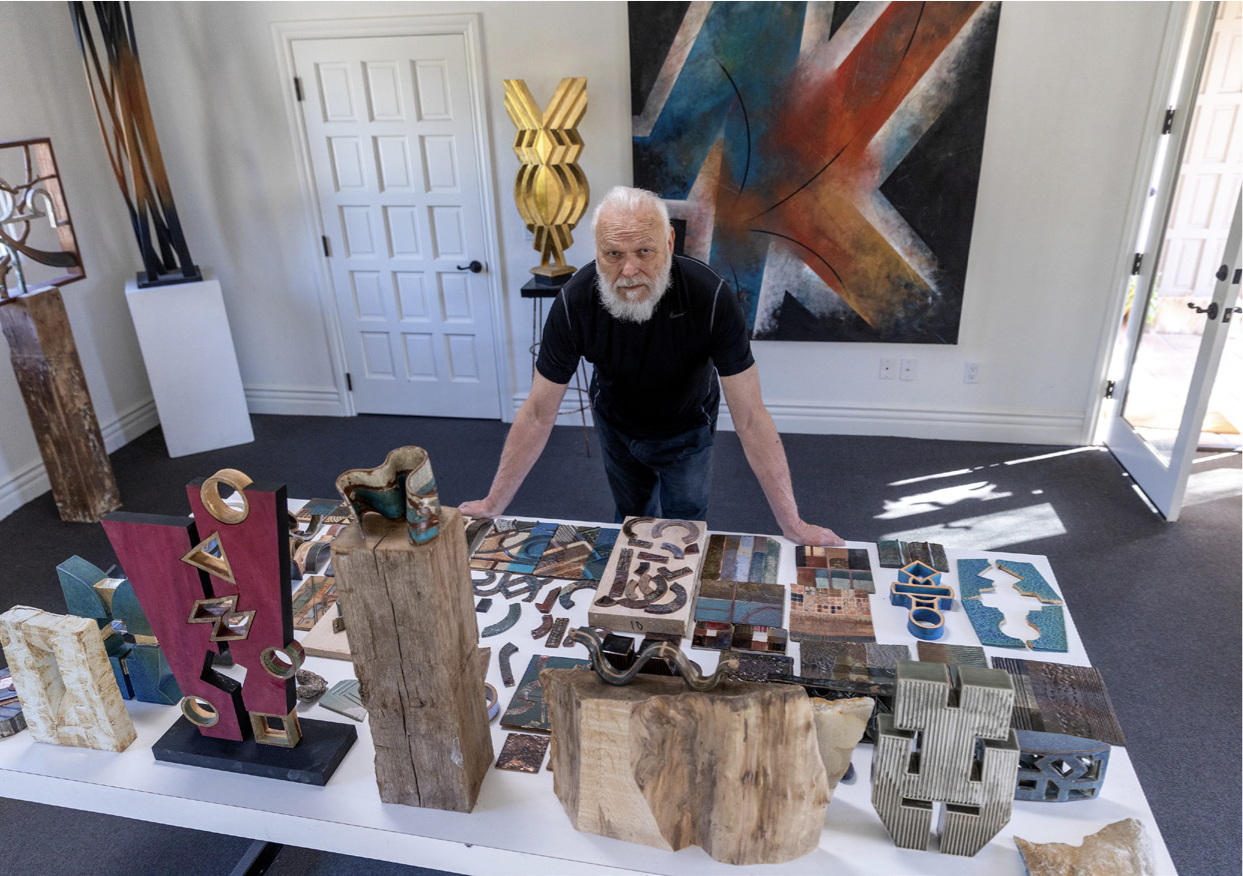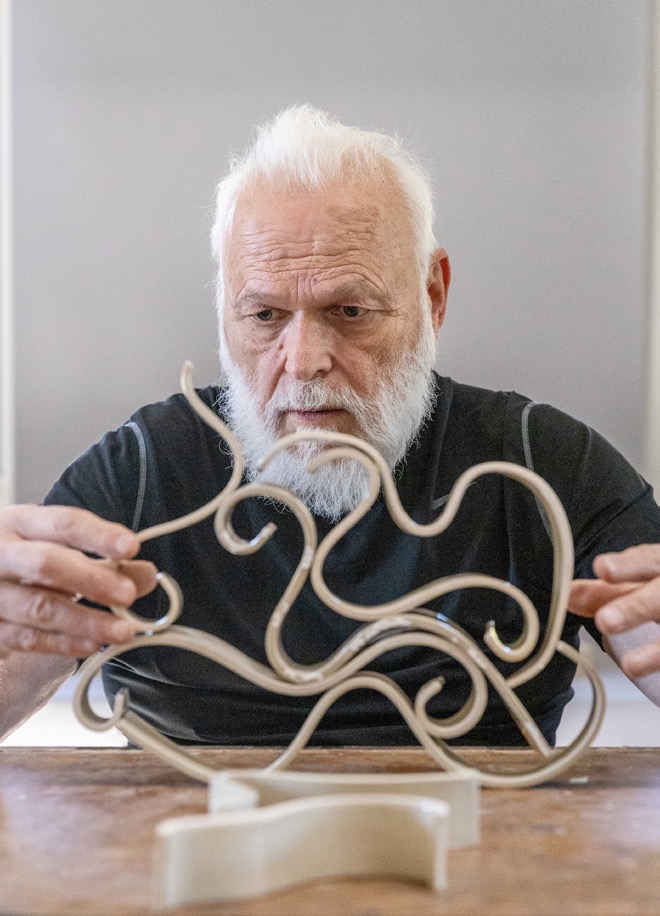It is one of the benefits of age that we can be multi-versed, that as a result of our experience we are complex beings. It is also true that we can take on new challenges, excel to new heights at this age. This is the moment to pursue what we feel is right for us; the future is narrowing, and as much as we would like to extend our health and life spans, there will be an end point. Contradictions in desires or ambitions in this context really don’t matter. This is the time to go for it.
James came to us as a story about athletics and as we dug in we found that, as with so many of us, there was much more — the artist, the athlete, the caregiver for an ailing partner, and the lover of life. These are only some of the many colors that have made up James Robie, senior competitive athlete and artist. A big thank you to Mark Hanauer for the magnificent images and for suggesting James to us.
Where are you based?
Ojai, California.
Can you walk us through your journey into the fitness world?
As an active youth moving from season to season from sport to sport one was always in shape. In fall there was football, in winter, basketball and ice skating, in spring and summer there was baseball and track and field, especially the jumping events, so I was always fit. That was my natural state. Now it’s different. You work out in gyms, with machines, with trainers. It’s different but the results can be the same.

Why do you compete in athletics?
From an early age I played sports of all kinds and I was good at almost every sport I tried. Being good and, in some cases, the best at something came a wonderful feeling of satisfaction. I want to be the very best at everything I do. It makes me feel good.
“I want to be the very best at everything I do. It makes me feel good”
Why track and field?
I discovered early in my life that I could run fast and jump high and far. Although I was good in other sports, track and field was an individual sport and when I got older it was something that was easy to do and didn’t require a lot of organization and since my time was limited it was a good fit.
How did your body change since starting track and field?
I’ve always been big; at 14 I was 6’3” and 180lb. In college I was 6’4” and 220. I’m 76 and I’m back down to 6’3” and 215. Now that I’m seriously training I’d like to get down to 200. With the added weight training I’m feeling stronger.
How did your mindset change?
If you’re talking about how does my mind react to what I’m doing, it’s something that I constantly have to deal with. I have to get my mind and body in sync. What I mean is, my mind doesn’t think it’s 76 years old. My body, although in good shape, isn’t 40 years old. They have to meet somewhere in between. Hopefully closer to 40.
What is your nutrition like?
I was lucky, my late wife Petrie was very food conscious and I benefited greatly from it. I eat primarily organic foods, a lot of fruits and vegetables, and some chicken and fish. Very little red meat. I try to stay away from processed foods and I read labels, especially for sugar content.
When you’re training for a competition, how do you promote muscle recovery? Any tricks?
No tricks. Just common sense, really. Plenty of water, some light stretching, and hopefully a good night’s sleep.
What do you do in preparation for an event like the world championships in Finland? Take us through your training process.
I have found since starting participating in the track and field masters program about 12 years ago that stretching and light exercise was the key. In preparation for the world championships, I’ve taken a slightly different approach. I’m now working with a trainer who not only has pushed me in my stretching program but has added weights and other elements to help condition my body but I still have to take it easy and listen to my body. In May, I’ll begin to do some actual jumping and that’s when I’ll know where I’m at competition-wise.
“I’ve competed against and beaten ex-Olympians”
Do you feel any limitations physically or mentally being an athlete your age?
Unfortunately, I do feel limitations physically. That’s just a fact of life. Mentally, less so. It’s what I was talking about earlier, getting my mind and body working together in sync. That is important. That’s why I love the master’s program. You’re competing against other athletes your age and you’re trying to be the best. And if being the best may not be a distance or height that you’re entirely happy with, that’s just the way it is. I’ve competed against and beaten ex-Olympians. We’re all just trying to do the very best we can.
Have there ever been any doubters who didn’t believe in you?
The direct answer is no, there hasn’t been anyone. Although someone recently told me that my late wife expressed concern that I might hurt myself. I don’t think that was doubt but rather concern.
What would you tell someone who is 50+ wanting to get control of their health and fitness?
First, I would say it’s never too late and so much is common sense. Take it slow, listen to your body, eat well, and get into a good routine where it’s fun. Your body and mind will thank you. Join a group or a master’s program. There are a lot of different sports out there.
You are also an accomplished artist. Could you draw a line for us between your creative endeavors and your athletic ones?
Discipline and focus. Each one requires enormous discipline and focus. Also, each one is goal-oriented. In some of my sculptures, which are complex and cannot be rushed, you also need patience. In preparation for competition, you need that same focus and patience.

Who is your art hero?
I have many but the one that constantly stands out is Brancusi, the Romanian sculptor who changed the face of sculpture in the early part of the 20th century.
Who is your athlete hero?
Again, I have many but I would say the Olympian Jesse Owens who I was lucky enough to meet in the early ’70s.
“Once an idea is born, I internalize it in my mind’s eye and I try to work out the mechanics of making it”
How do you begin to create a piece? What’s your starting point?
My mind is always visualizing no matter what I’m doing. It could be a doodle or scribble while I’m talking on the phone. It could be a geometric shape I see in the urban environment. Once an idea is born, I internalize it in my mind’s eye and I try to work out the mechanics of making it. Once I think I’m capable of making it, I’ll put it to paper and then physically make it.
How do you know when a piece of your art is finished?
In most cases when the piece is planned out, and many of my complex earlier carved pieces definitely had a beginning and an end. My new pieces are more free-flowing with a lot more individual pieces that are combined into one single finished piece. These pieces are more open-ended and can change as I work. They’re usually done when they “feel” finished and there’s nothing more that can be done to improve it.
What do you want the viewer of the piece to get from the experience of being with your work?
A sense of wonder. I know that sounds profound but it’s true. It can’t be with all pieces, but the ones that I find the most successful are those that have a sense of mystery. Either: “How did he do that?” or “That’s amazing.” I want it to be a unique experience.

What was it like being the caretaker to your wife when she was battling cancer?
My wife Petrie battled cancer for over 6 years. She was a very strong woman and for the first 5 1/2 years we lived a very normal life, although centered around her treatments. Toward the end, when things changed and my role as caretaker became more pronounced, our relationship became more intimate. By intimate I mean the connection between us was such that all emotional barriers that might have been between us vanished. We shared our feelings and memories freely and there was a closeness that was truly special.
“My wife Petrie was a very special person”
Tell us about your wife. When did you meet and how long were you married?
Petrie was a very special person. First of all, she was beautiful. She was also very creative. She came from a family of Russian dancers so she was a trained ballet dancer. Later in her 20s, she hosted a radio show for Pacifica KPFK called Jazz Los Angeles where she would record live sets at Shelly’s Manne Hole and then interview the musicians during their breaks. Musicians like Cannonball Adderley, Art Blakey, and the Jazz Messengers, to name a few. She also produced radio documentaries, Death in Venice USA and Little Bit of Honky Tonk, Gemini GEL. That morphed into being a sound artist working with pure sound and collaborating with various artists including George Herms and Robert Rauschenberg with whom she worked on the Art and Technology Exhibition at LACMA. She also produced a poetry show for KCRW. With the birth of our first child, our son Alexis, and later our daughter, Honor, she funneled all that energy into raising our family.
She was also an astute businesswomen helping me run my design firm as well as running the Coronet Theatre, a legitimate stage theatre her mother built in the ’40s.
We met in 1968 at the UCLA extension program where she was taking a silk-screening class and I was a TA (teaching assistant).
We were married for 50 years.
“I think it’s only normal when someone passes you start to look at life differently”
Has that changed your art or your outlook on life?
I don’t think it’s changed my art. I think it’s only normal when someone passes you start to look at life differently. That we’re not here forever and we only go around once so make the most of it. There’s a song lyric that keeps going around inside my head: “Someday you’ll leave this world behind so live a life you will remember.”
Favorite books, or recent best reads?
The biography of Frederick Douglass and The Code Breakers.
What is your ambition for the next five years?
To have an exhibition entitled “Robie at 80, the Ojai Years” and to be still able to compete athletically.
What are your 3 life non-negotiables?
1. Don’t compromise in my work.
2. Live a full and active life.
3. Be a good person.
Connect with James Robie here.
Main image by: Mark Hanauer.
The ideas expressed here are solely the opinions of the author and are not researched or verified by AGEIST LLC, or anyone associated with AGEIST LLC. This material should not be construed as medical advice or recommendation, it is for informational use only. We encourage all readers to discuss with your qualified practitioners the relevance of the application of any of these ideas to your life. The recommendations contained herein are not intended to diagnose, treat, cure or prevent any disease. You should always consult your physician or other qualified health provider before starting any new treatment or stopping any treatment that has been prescribed for you by your physician or other qualified health provider. Please call your doctor or 911 immediately if you think you may have a medical or psychiatric emergency.


